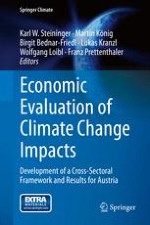2015 | Buch
Economic Evaluation of Climate Change Impacts
Development of a Cross-Sectoral Framework and Results for Austria
herausgegeben von: Karl W. Steininger, Martin König, Birgit Bednar-Friedl, Lukas Kranzl, Wolfgang Loibl, Franz Prettenthaler
Verlag: Springer International Publishing
Buchreihe : Springer Climate
